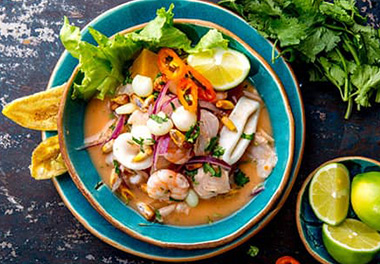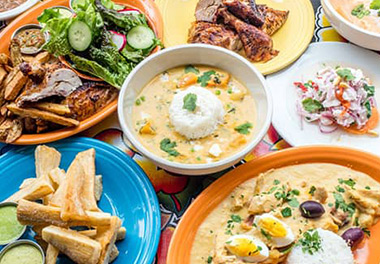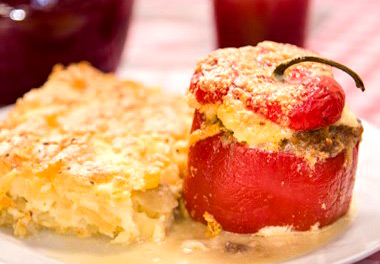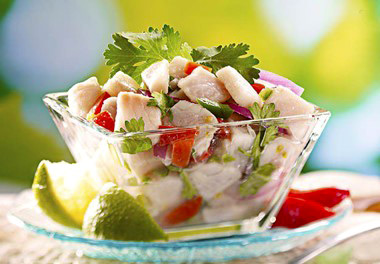
Much more than the land of the Incas
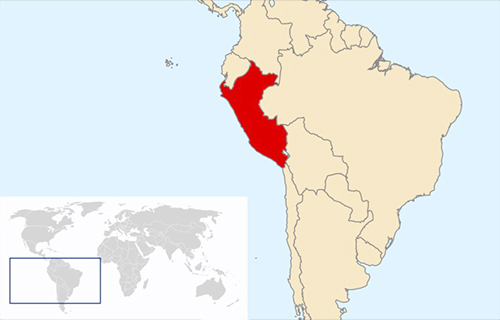 Peru is a country located in the central and western part of South America, facing the Pacific Ocean. Borders with Ecuador and Colombia to the north, with the Brazilian states of Amazonas and Acre to the east, Bolivia to the southeast and Chile to the south. Extension With 1,285,215 km2, Peru is the third largest country in South America, after Brazil and Argentina, making it one of the 20 largest countries in the world. Peru also has two hundred nautical miles of the Pacific Ocean and territorial rights over an area of 60 million hectares in the Antarctic. Population 32 million inhabitants, with an urban population of 72.3% and 27.7% at the rural level.
Peru is a country located in the central and western part of South America, facing the Pacific Ocean. Borders with Ecuador and Colombia to the north, with the Brazilian states of Amazonas and Acre to the east, Bolivia to the southeast and Chile to the south. Extension With 1,285,215 km2, Peru is the third largest country in South America, after Brazil and Argentina, making it one of the 20 largest countries in the world. Peru also has two hundred nautical miles of the Pacific Ocean and territorial rights over an area of 60 million hectares in the Antarctic. Population 32 million inhabitants, with an urban population of 72.3% and 27.7% at the rural level.
Language
Spanish and Quichua are the two official languages. As part of its cultural wealth, Peru has a multitude of languages. Quechua is the most important native language, and it is spoken in most cities in the Andes. The Aymara is spoken in some areas in the Puno region. In the Amazon, a multitude of indigenous dialects are spoken. These dialects are spread over an astonishing variety of families, as those who even in these days survive giving birth to 45 different languages.
Religion
Peruvian people are believers by nature: the diversity of beliefs and freedom of worship are manifested in a variety of festivities and rituals that reflect both the catholic fervor (part of the Spanish heritage) and the mysticism of the ancient pre-Hispanic cultures. Ninety percent of the population is catholic, 6.73 percent are Christians, 2.56 percent are from other religions and the remaining 1.65 percent has no religion.
Currency
The official currency in Peru is the Sol (S/.). Divided in 100 cents. Circulating coins of 1, 5, 10, 20, 50 cents; 1, 2, 5 soles and bills of 10, 20, 50, 100 and 200 soles.

Regions and Climates
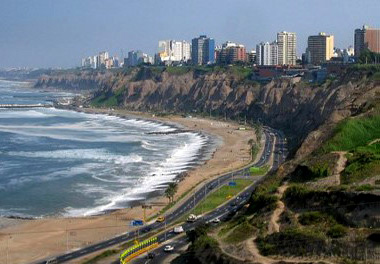
Coast
Lima, the capital city, is in this region. Is a coastal plain bathed by the Pacific Ocean, with desert areas, beautiful beaches, and fertile valleys. Most of the country’s cotton, rice and sugar plantations are in this region, as well as the offshore oil wells. Lima is the only South American capital city located by an ocean.
LIMA is a city of mild weather, with no major rainfall in the winter nor excessive heat in the summer. The average temperature during the summer (mid-December to mid-March) is 25ºC. And in the winter, which is characterized by its gray, damp, and cloudy days the average temperature fluctuates between 12 º to 15ºC. In the COAST: There are two very marked seasons: summer (December thru March) with temperatures reaching 27ºC (80ºF) and winter (May thru October) very humid and cold with temperatures in between 12º to 15ºC (53ºF).
While on the Peruvian coast it almost never rains it is common to experience mist and exceptionally light drizzles or known as “garuas”. The north end of the coast has sunny days all year long, reaching temperatures of 35ºC (95ºF).
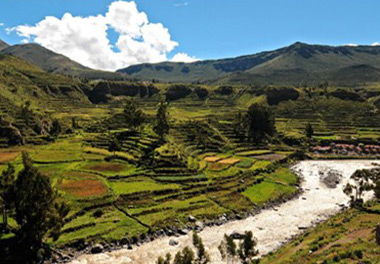
Sierra
This region is dominated by the Cordillera de los Andes. It reaches 6,768 meters above sea level (22,204 feet) at the summit of the snowed covered Huascaran. Most of the countries mineral resources are in this area, like silver, zinc, lead, copper, and most of the country livestock.
The SIERRA’S WEATHER: Very dry and mild weather with two seasons very well defined. One dry period (May to October), with sunny days, cold nights, and very little rainfall – the ideal time to travel – the other, the rainy season (December thru March), with abundant rainfall.
In the Sierra is quite common to go from 20ºC (68ºF) to 2ºC (35ºF) all in one day.
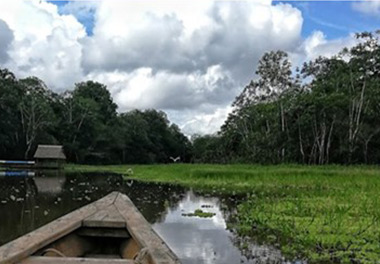
Jungle
It is a region of tropical vegetation that belongs to the Amazon, where most of the Peruvian natural reserves are located. It is an area of very fertile upland of the subtropical type. The Amazon forest is in the eastern part of Peru and it is full of natural resources.
Weather in the JUNGLE: It has a tropical and humid climate. It has two distinct seasons: one is the summertime (May thru December), with sunny days and temperatures above 30ºC (86ºF) and the other is the rainy season (November thru March).
You can find information about Peru’s weather at: SENAMHI or The Weather Channel.

Gastronomy
Peruvian cuisine is considered among the best in the world.
Inherited its innovation, mix and flavors from Peru’s history. Its culinary fusion developed over a long process of cultural exchange between the Spanish, Africans, Chinese, Japanese and Italians, among others. The dishes became more and more varied as races mixed, and migrants landed at the port of Callao. This fusion gives rise to dishes like the unique anticucho de corazon (skewered cow heart), tacu-tacu stew and carapulcra, dishes which have African heritage. Nutritious pastas arrived along with Italian migrants, whose adaptations have resulted in traditional dishes like green or red pasta. Ceviche, Peruvian’s emblematic dish, emerged from a fusion with Japanese cuisine. Lastly, the trend of Novo-Andean cuisine boasts indigenous foods worthy of the most elegant settings, reclaiming the national flavor that is such an important part of our identity.
Peruvian Cuisine.
Responding to their history, Peruvian Cuisine has a unique variety in the world. In various parts of the country, we find proposals that will be responsible to sweeten our palate. The cuisine of Lima, North Shore, Amazon, Arequipa, Andean and Novoandina expected to reach your table to live a unique dining experience.
Cuisine of Lima.
Without a doubt, Lima’s cuisine has earned it an excellent and well-deserved position as one of the top gastronomic capitals of the world. In addition to hosting the most important food fair in Latin America, its culinary variety delights locals and visitors alike. With its iconic dishes, ceviche and tiradito, Lima is a prime destination for those who love good cuisine. Its gastronomy is the result of disparate influences: African, indigenous, and Chinese, which all coalesce in delicious dishes that enchant even the most demanding palates.
The capital of flavor and good dining, Lima offers a great variety of traditional dishes served in venues ranging from five-star hotels to restaurants to ceviche joints and chicken shops, markets, “huariques” and “chifas” (Chinese restaurants). Considered the center of regional cuisine, it also hosts the most important food fair in Latin America: Mistura.
Its captivating cuisine takes the form of an extensive menu of dishes with fish as the star ingredient, and ceviche, a source of national pride. Tiradito, a version of ceviche without onion, and “parihuela”, fish soup with shellfish, are typical seafood dishes. Others on the long list include rice with shellfish, chorrillana-style fish, shells a la parmesana, mussels a la chalaca (cooked in lemon and served in their shells), jalea mixta (fried fish and other seafood), tequeno pastries stuffed with crab meat, tuna-stuffed potato cake, fried rice with fish, pastas with seafood sauce, etc.
The African influence brought to our cuisine the offal used for the famous anticuchos, which are skewered cow hearts grilled over a charcoal fire; cau cau, a stew of tripe and potatoes; and tacu tacu, refried beans mixed with rice and topped or stuffed with meats or seafood.
The Peruvian-Hispanic fusion created dishes such as causa limena, a potato puree stuffed with poultry, seafood, or avocado and tomato; tamales, a spiced ground corn paste filled with chicken or pork; and ají de gallina, a creamy stew of hot peppers, milk, bread and spices with shredded chicken breast.
The Chinese influence also led to new culinary delights that please the palate with delicious dishes such as arroz chaufa, rice cooked and fried in soy sauce with small pieces of chicken, pork, egg and green onions, and lomo saltado, which is sautéed potato, meat, onion, tomato and hot peppers, seasoned with soy sauce.
Deserts are another source of creativity. The purple mazamorra pudding, rice pudding, el suspiro a la limena custard, turron de dona Pepa cake, and the deep fried picarones pastries all represent the sweeter side of meals in Lima. The purple corn beverage known as chicha morada, along with beer and Inca Kola, a yellow soda drink, are all traditional drinks in Lima.
The Cuisine of the Northern Coast.
The cuisine of Peru’s northern coast fits perfectly with its warm climate and offers a delectable variety of seafood and fish to the most discriminating tastes of our visitors. A delicious way to savor the varied flavors of ceviches and sudado stews is by accompanying it with a cold beer or corn-based chicha de jora. Red meat lovers can enjoy our exquisite cabrito kid meat from the goats raised in the area. This dish, among a cornucopia of both sweet and savory dishes, make the northern coast an ideal place to visit. Tumbes, Piura, Lambayeque, and La Libertad.
The northern regions have a warm climate and seas teeming with fish and seafood. Their most prized dishes include ceviches and sudado stews, which combine ingredients harvested from the sea with sour and spicy flavors, and aromatic herbs that provide fresh and intense flavors. Ceviches are made with fish, seafood, or black shellfish, all marinated in lemon juice, hot peppers, salt, and served with onions, sweet potatoes and corn in kernels or on the cob. Chinguirito is a special type of ceviche made with the salted and dried meat of the guitarfish. Main dishes include sudado de pescado fish stew or steamed fish. Fried cassava, clams with parmesan and chifles (round slices of fried plantain) are great hors d’oeuvres to share. All food in the north is accompanied by an ice-cold beer or chicha de jora corn beer. Many people in this area raise goats, so seco de cabrito (stewed goat meat) is a common dish. Another dish is the seco de chabelo, prepared with grilled beef and roasted and shredded plantain. Rice with duck, flavored with dark beer, is also a classic. Sopa teologa (Priest’s soup), a broth prepared with turkey, and shambar, another soup prepared with beans, pork, and beef, are also emblematic of northern cuisine. The north, like any region, has its desserts: the popular quince jellies and the King Kong, a huge alfajor cookie filled with pineapple jam and white manjar (caramel). Aside from restaurants, these flavors can be sampled in chicherias, where the cooking is done over a wood fire and with clay pots, or in “huariques,” famous for their special homemade flavor.
Amazonian Cuisine.
If only given one phrase to describe the varied cuisine of the Peruvian Amazon, it would be “culinary delight.” Food from the Peruvian Amazon not only entices with its exotic dishes, but also attracts travelers with its great variety of delicacies such as beef, poultry, fish, mutton and pork.
It also offers other examples of Pachamama’s abundance, such as majaz, with its lean meat and delicious flavor, or plantains, used as a main ingredient in many recipes. And what better companion for this tantalizing food than the fresh juice of countless kinds of fruit, or other drinks, such as masato guaranteed to pamper the palate of our most indulged visitors. Loreto, Ucayali, San Martin and Madre de Dios.
Food from eastern Peru is exotic. The biodiversity of its resources seems infinite. Chonta or palm heart, harvested from palm trees, is an important element of Amazonian cooking and is used to make salads. The meats eaten are diverse: beef, poultry, fish, lamb, and other gamey meats such as majaz, prized in the area for its delicious flavor and lean meat.
The plantain is another key ingredient in Amazonian food. It is used to prepare tacacho, which is often served with pork cracklings or dried pork. Juanes, pieces of chicken packed in cooked rice and wrapped in bijao leaves to cook; roast picuro, a species similar to the guinea pig; apinchado, cuts of pork stewed with peanuts and corn; and patarashca, fish steamed in leaves in hot coals, are all examples of the flavors proffered by the Amazonian tables.
Noteworthy soups include inchicapi, chicken prepared with peanuts, cilantro, and cassava, and carachama soup, made from fish and accompanied with plantains and cilantro.
When it comes to drinks, the Amazon offers remarkable fresh juices made from countless types of fruit, such as aguajina and cocona, as well as concoctions like masato or chuchuhuasi, which is alcoholic, or uvachado, a fermented grape beverage, and chapo, prepared with banana and/or milk.
Andean Cuisine.
The Peruvian mountains are synonymous with variety. Andean cuisine abounds with stews, soups, meats, and exquisite desserts made from corn, milk, and fruits. Combining the high nutritional value of the Andean ingredients in a traditional earthen pot over a wood fire to create the most delicious dishes of this hearty cuisine would be any chef’s dream.
Chicha corn beer was the traditional beverage of the ancient inhabitants of the Andes, and the tradition still lives on today. If you wish to sip the exotic liquors distilled in the highlands, you can choose between wines and artisanal ciders, the most common drinks apart from chicha. Don’t forget to try the breads and the wawas, santiagos, and bolitos de agua pastries, which, without question will give your already ecstatic palate a new thrill. Cajamarca, Amazonas, Áncash, Junín, Pasco, Huancavelica, Apurímac, Ayacucho, Cusco and Puno.
The Peruvian highlands have an abundance of highly nutritious ingredients that the ancient inhabitants of Peru learned to combine to create pleasing flavors without sacrificing their natural properties. The wood-fired ovens and ceramic pots are part of the Inca wisdom that preserves the nutrients of food through a slow and aromatic cooking process.
Meats, tubers, grains and herbs are the foundations of this healthy culinary tradition. The simple way of cooking, with little seasoning, guarantees easy digestion. Corn with cheese, corn salad, corn kernels with cracklings, cancha (roasted corn kernels), humitas (ground, cooked corn cakes), and papa a la huancaina (potatoes in a spicy cream sauce) are on the menu of any Andean restaurant. This selection of dishes includes meats, corn, maize, potatoes, cassava, cheese, peppers, peanuts, and herbs. The food of the Peruvian mountains is hearty.
Pachamanca is a mixture of beef, lamb, pork and cuy (guinea pig), marinated in chicha de jora and herbs and then cooked, along with fava beans, potatoes and humitas, on hot stones in a hole in the ground covered over with earth and corn husks. Patasca, a soup made from corn kernels; cuy chactado, guinea pig fried with a stone on it; cecina, dried and dehydrated meat served with onion sauce; and puka picante, a pork and potato stew seasoned with red pepper and beets are all examples of the Andean culinary tradition.
Traditional Andean soups include chochoca, made from corn flour; sopa verde, a kind of chowder made of cheese and the paico herb; kapchi, a fava bean stew; lawa, with fresh corn, fava beans, dried yellow ají peppers and the huacatay herb; chuño or morraya, made from dehydrated potatoes; and chairo, with beef and lamb, wheat, potatoes, fava beans, pumpkin and chuño.
The desserts feature corn, milk and highland fruits. Worth a taste are chapana, the fresh cheese with honey, the coconut cocadas, the manjarblanco (caramel) and the jaleas (blackberry and elderberry preserves).
When it comes to liquors, artisanal wines and ciders are the most common, along with corn chicha. Homage is also paid to bread: wawas, santiagos, bollos de agua and tres puntas are different types made from wheat, barley, corn, oca, anise, potato and sweet potato.
Cuisine of Arequipa.
You will love Arequipa’s food and restaurants, also known as picanterias, where the delicious aromas of the regional repast waft through the air along with the heat of wood fires. Rocoto peppers, the area’s iconic delicacy, solterito cheese salad, white soup, pork crackling, guisado stew, and the famous adobo dominical all entice visitors. And what about the desserts? Food of the gods! During your fortunate encounter with the White City of Arequipa, don’t forget to try the traditional corn chicha accompanied by a delicious anise drink, Nájar, which eases digestion.
What more could you ask for? The picanterías of the White City are the modern expression of an ancestral custom in the region that merges rural life with food and dining. These traditional restaurants still cook over a wood fire, a natural source of heat that intensifies the aromas of the food’s seasonings.
An emblematic dish from Arequipa is the rocoto pepper stuffed with pieces of meat, cheese, eggs and olives and blanketed with a generous slab of melted cheese. Other entrees unique to Arequipa are solterito de queso, combining fava beans, corn, olives, hot pepper and chunks of cheese with a lemon and herb dressing, and ocopa, consisting of four or five slices of cooked potato slathered with a sauce made of milk, cheese, peanuts, hot pepper, onion, crackers and shrimp tails.
Like all mountain towns, Arequipa offers succulent soups. The most acclaimed are the hearty and healthy white soup with lamb loin, potato, corn, garbanzo beans, chuno (dehydrated potato), and spices; puchero soup, a stew with of beef, pork, and chicken with vegetables and herbs; and shrimp chowder, containing shrimp with milk and cheese.
On Sunday mornings in Arequipa, you will find adobo, a main dish made from pork loin, ají pepper, onion, and chicha de jora corn beer. The locals also enjoy fried pork crackling and stews, which form the base of their spicy dishes such as spicy pork, beef, lamb and duck; as well as locro, a stew made from pumpkin with beef or lamb, and malaya frita, which consists of stewed and browned beef brisket served with fried cassava and onion sauce. Arequipa offers a variety of desserts. Bunuelos pastries are made from flour, eggs and milk and served in molasses. Queso helado (frozen cheese) is prepared with coconut, cinnamon, milk and spices, and once it has set, served with honey or by itself.
Arequipa’s chocolates and toffees are also famous. The traditional beverage is corn chicha or chicha de jora or Najar anis, a digestif traditionally consumed after eating pork. Novo-Andean cuisine Novo-Andean cuisine is a new style originating from Peru that reclaims the culinary customs of its pre-Hispanic past and, therefore, rediscovers many local ingredients.
The recreation of Andean cuisine draws on elements from other cultural landscapes, such as Europe. What better way to combine healthy cuisine with Novo Andean flavors, yielding an intense variety of dishes that delight even the most discerning palates? Discover which foods and ingredients from Peruvian cuisine make Peru a good destination to visit and enjoy.
Metropolitan Lima.
In recent decades peruvian chefs have taken the ingredients used by their ancestors before Spanish rule and successfully incorporated them into international cuisine.
A new culinary style emerged, which draws inspiration from the culinary traditions of pre-Hispanic Peru and combines them with trends in international cuisine. Perfect harmony has been achieved with sparing use of spices in lightly cooked, mild flavored and very low-fat dishes. Some Novo-Andean dishes include: Appetizers and soups: antojos de queso en salsa de maracuya (cheese and spinach rolls in a passion fruit sauce), fresh snail and quinoa salad, cheese flan with barley flakes, cassava casserole, and cream of celery and leek soup with barley flakes.
Entrees: grilled alpaca, fish marinated in carob syrup, reventon ayacuchano (made with the same ingredients as pachamanca and sancochado, but in an earthen pot with more sauces), quinoa risotto, cassava and dehydrated potato stew, guinea pig in oyster sauce and veal with squid.
Desserts: imperial de quinua (quinoa with milk and a passion fruit jelly), quinoa and soursop mousse, oca tart (made with the sweet oca tuber and cherimoya), misky súmac (made from amaranth), canihua pudding and pacay (ice-cream bean) nougat.
Beverages: goldenberry shake, quinoa and mamey chicha, grape and canihua chicha, maca sour, sour cocktail made of Andean or Amazonian fruits, tumbo frozen (banana-passionfruit frappe), and others. General information: Novo-Andean food can be found at 5-star hotels and specialty restaurants in the city of Lima, which offer an impressive selection of dishes.
Source: PromPeru.
